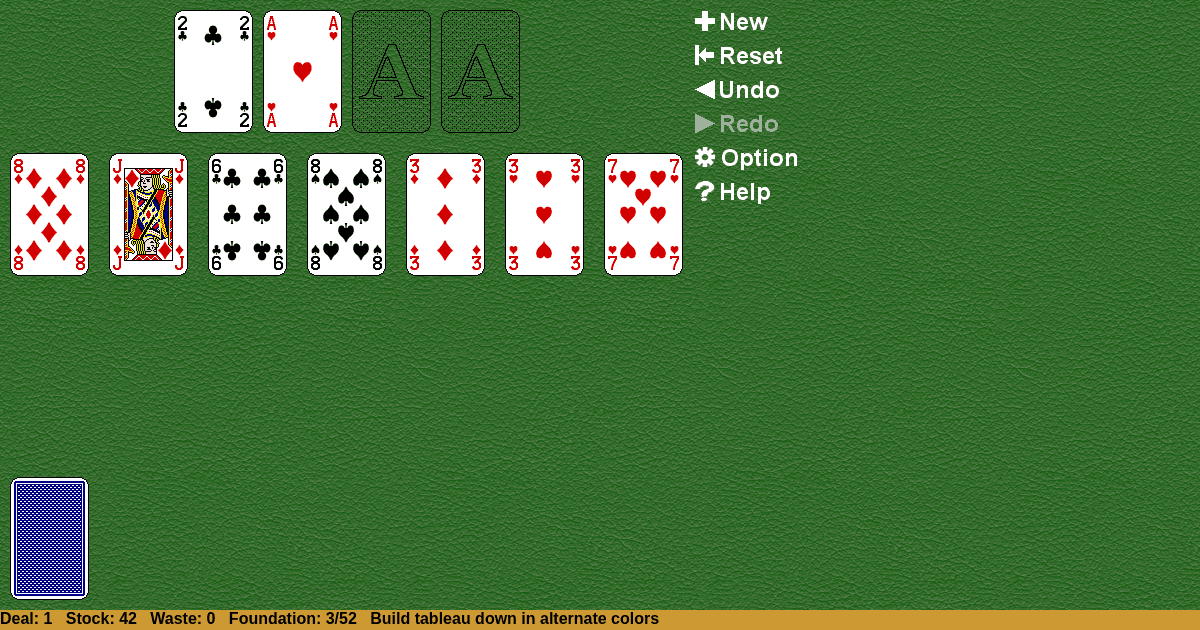Whitehorse
Home |
How to play |
FAQ |
About
How to play Whitehorse?
Game Objective:
The primary goal in Whitehorse Solitaire is to move all cards from the tableau and stock to the four foundation piles, building each pile in ascending order by suit from Ace to King.
Setup & Layout:
- Deck: Whitehorse Solitaire uses a standard 52-card deck.
- Tableau: Seven tableau piles are created. Each pile is dealt one card face up; any additional cards in the pile are dealt face down beneath the top card.
- Stock: The remaining cards after the tableau setup form the stock, placed face down in the upper left corner of the play area.
- Foundations: Four empty foundation piles are positioned, typically in the upper right. Each foundation pile is dedicated to a single suit and begins empty.
- Waste: Cards drawn from the stock that cannot be played are placed in the waste pile.
Key Play Areas:
- Tableau: Seven columns where cards are arranged and manipulated during play.
- Foundations: Four piles where cards are built up by suit from Ace to King.
- Stock: The face-down pile from which cards are drawn.
- Waste: The pile for unusable stock cards.
Whitehorse Solitaire Rules:
- Card Movements:
- Cards may be moved between tableau piles, from tableau to foundation, or from stock/waste to tableau or foundation.
- Building Sequences:
- Tableau: Cards are built down in descending order, regardless of suit. Only single cards may be moved at a time.
- Foundations: Cards are built up in ascending order by suit, starting with Ace and ending with King.
- Moving Cards:
- Only the top face-up card of each tableau pile is available for play.
- When a face-up card is moved, the card beneath it (if any) is turned face up and becomes available.
- Cards from the stock are drawn three at a time and placed in the waste. The top card of the waste is available for play.
- Empty tableau piles may only be filled with a King.
Gameplay:
- Turn Sequence:
- Move available cards between tableau piles, following the descending order rule.
- Move cards to foundations whenever possible, following suit and ascending order.
- Draw three cards from the stock pile when no moves are available. Place unplayable cards into the waste.
- The top card of the waste may be played to the tableau or foundation if legal.
- When a face-down card in the tableau is exposed, turn it face up.
- Redeals:
- When the stock is exhausted, the waste pile may be turned over to become the new stock. Unlimited redeals are allowed in Whitehorse Solitaire.
- No Legal Moves:
- If no moves are possible and the stock is exhausted, the game ends.
Winning & Losing Conditions:
- Winning: The game is won when all cards are successfully moved to the four foundation piles, each built up in suit from Ace to King.
- Losing: The game is lost or unwinnable if no legal moves remain and the stock cannot be replenished, preventing further progress toward the objective.
Special Rules & Edge Cases:
- Filling Empty Spaces: Only Kings may be placed in empty tableau piles. No other card is permitted to fill an empty space.
- Sequence Movement: Only single cards may be moved at a time, not sequences.
- Redeal Limit: There is no limit to the number of times the waste can be recycled into the stock.
- Face-Down Cards: Whenever a face-down card in the tableau is exposed, it must be turned face up immediately and becomes available for play.
- Stock Draw: Cards are drawn from the stock three at a time, not one at a time.
Note: Whitehorse Solitaire is distinguished from other solitaire variants by its restriction to moving only single cards and its unlimited redeal rule.

Solitaire Collection
About Whitehorse
Rate (Whitehorse)
4.7 / 5
1,916 votes



























































